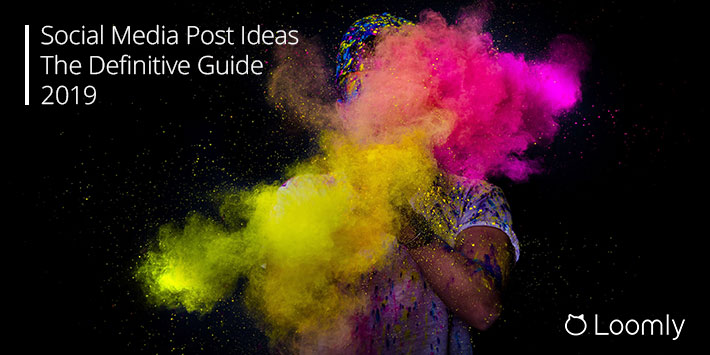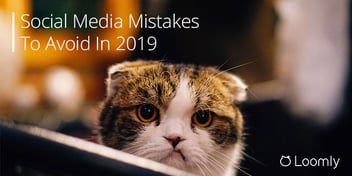Social Media Post Ideas: The Definitive Guide
Let’s face it:
Coming up with new social media post ideas is one of the toughest parts of the social media manager‘s job.
It feels like you spend a lot of time staring at a blank spreadsheet wishing you knew what to share this month.
When your colleagues ask how the planning is going, well… you feel a little like this when you tell them:

Somehow you always manage to come up with just enough good ideas to get you over the line.
But, it is a hard-fought battle, and you know it is not long until you have to do it all over again.
Would it not be great if you could plan your social media updates without the stress, worry and constant fight against writer’s block?
We think so too.
That is why we put together this definitive guide of social media post ideas.
In this guide, we will show you exactly the steps you need to take to generate high-quality social media content every month, with a list of prompts which will keep the ideas flowing for years to come.
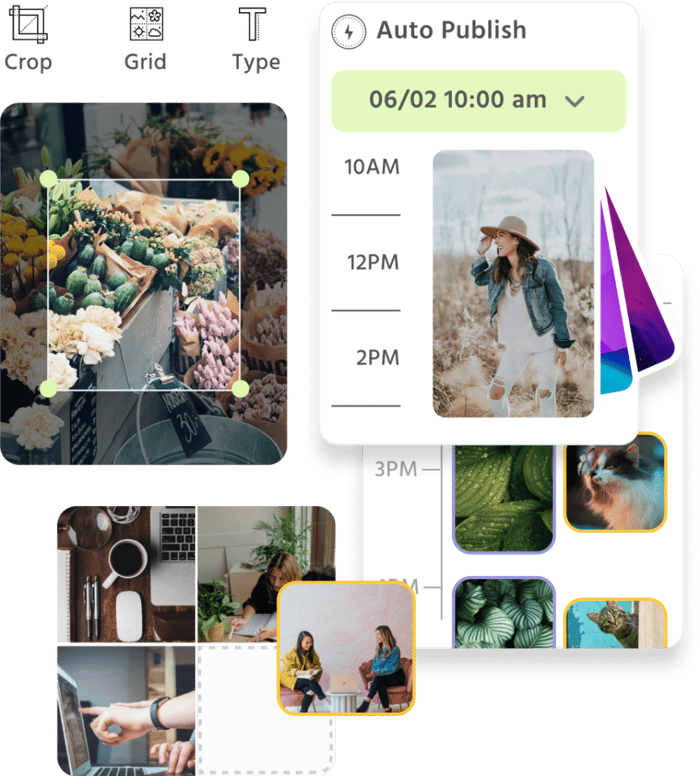
Manage all your social media accounts in one place.
Craft, schedule, & auto-post content to all your social channels, then track analytics and manage interactions from a single, easy-to-use dashboard.
The 6-Step Method To Fill Your Social Media Calendar
The method you are about to learn will teach you how to generate an endless supply of social media post ideas.
You can use this method to generate updates starting today, through to any point in the distant future. Whatever works for your cycle!
To use this method most effectively, we recommend you keep your publishing cycles short — a maximum of four to six weeks — and use social media analytics data to make frequent adjustments.
This short-cycle also ensure you share up-to-date content and discuss the most current and trending themes your audience wants to know about.
So, pour a drink, grab your spreadsheet (or open up your favorite social media calendar) and let’s get to work.
“Find your sweet spot: the intersection between what you know and what your customers need to know.” — Joe Pulizzi
Step 1: Determine Your Cornerstone Brand Dates
In this first step, we are going to create your cornerstone content.
These are the most important dates for your brand over the coming cycle, where you will be able to see the most return on investment.
These dates could be in the form of:
- Product launches.
- Product updates.
- Company events (or events you sponsor).
- Company milestones.
- Conferences.
- Changes in season & collections.
We start with these type of updates because they are time-bound and easy to create original content for.
For each brand event, you assign a specific date on your social media calendar and create updates around it.
There are two ways you can approach this:
- Firstly, you can create one-off updates for the standalone events: these updates are especially good for milestones or small product updates you just want to make people aware of.
- Secondly, you can use these events to dictate the updates before and after the important events: let’s take a closer look at how this might look.
Karhu, a Finnish lifestyle and running footwear brand, use major brand events to anchor the rest of their social media updates.
Take the Venice marathon, for example, which they sponsor.
On the day of the marathon, they have a one-off update with a warm message to everyone participating in the race:
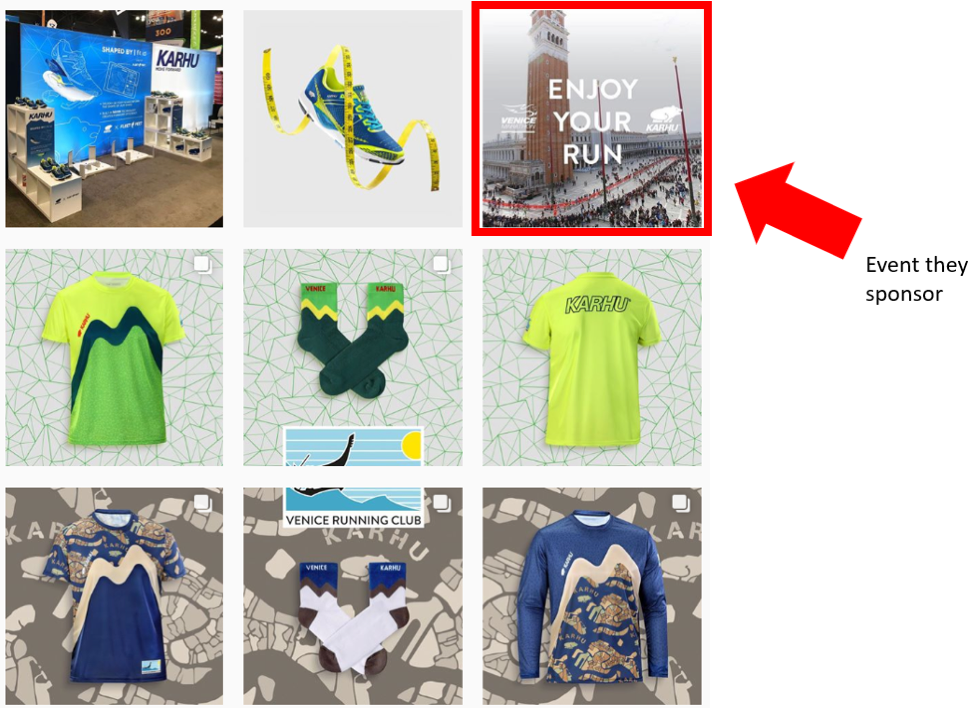
When you take a closer look at their feed, though, you can see that the updates surrounding this event are all relevant, too.
In the build-up to the race they talk about limited edition products which are relevant to the upcoming race.
Then, after the race, they share a few extra updates talking about where you can find them, and shoes they recommend for racing:
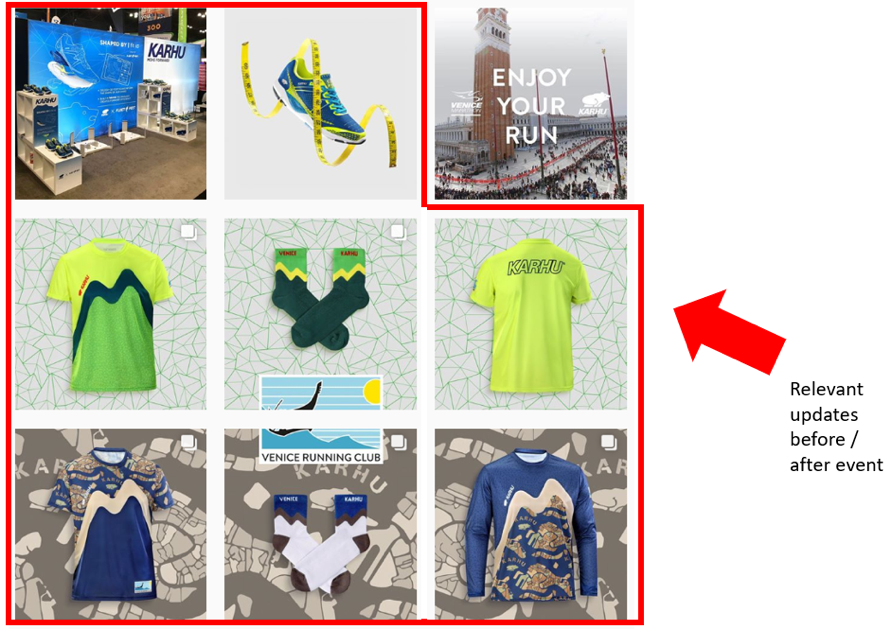
They also employ this strategy with their product launched, too.
Their usual posting schedule focuses on their product launches — in this case, a new line of shoes — which “triggers” all of the updates which come in the months and weeks afterward:

Using these “anchors” is a cool trick which helps you to bring order to your social media calendar and makes scheduling more systematic.
Take some time to sit down with your company’s official calendar, or members of different departments, to find out about upcoming dates which you can work with.
Then, create your first round of posts around those events.
Step 2: Sync Calendars With Your Content Creators
If you are using social media to help you market your brand, there is a good chance you are creating other types of content like:
- Blog posts.
- Podcasts.
- YouTube videos.
- Infographics.
This long-form content tends to be your most valuable asset, and it is where you are likely to have the biggest impact on your customers. So, it is important to share this on social media.
You may need to sponsor posts to get the most eyes on this content, but it can have a really good long-term return on investment.
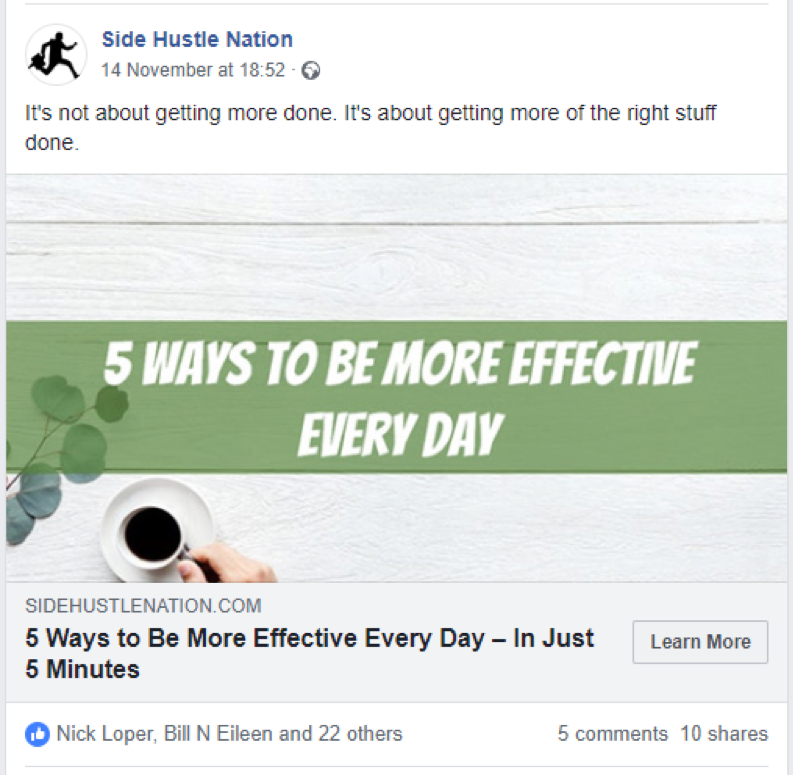
Publishing fresh content from your blog can cause some scheduling issues. Even if everything is planned well in advance, you are going to need an active link for it to look right on social.
To remedy this, we recommend you batch your content uploads once a week (or every two weeks) from the previous period.
For example, every Monday you could upload your website content from the last seven to 14 days.
If you are in a small team and this does not feel possible, then you can also do this weeks or months after the content has been published on your blog or sent to your mailing list.
Step 3: Turn Your Long-Form Content Into Mini-Updates
In this step, you are going to learn how to turn the content in your blog posts, podcasts or other pieces into standalone updates.
Basically, you are going to repurpose what has already been created and turn it into a shorter, social media friendly content.
Gary Vaynerchuk calls this the Content Pyramid, and he explains it quite succinctly in this slide:
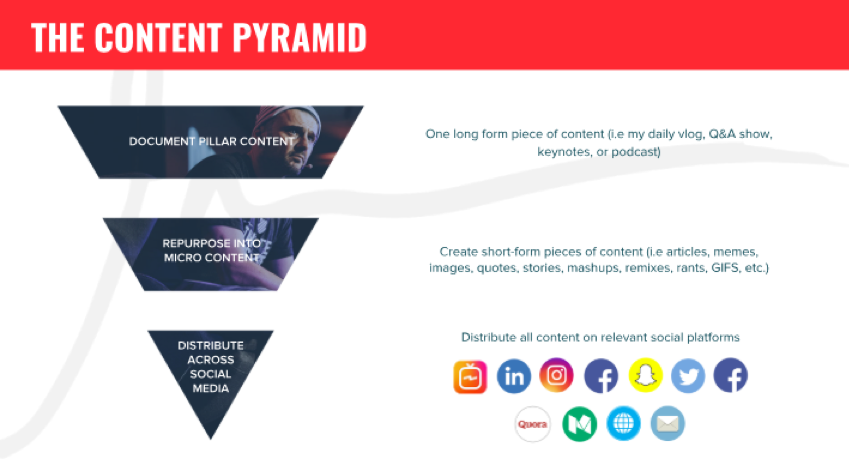
The process is pretty simple and is easy to implement by anyone who is producing content.
Simply put:
- Take your long-form content.
- Break it down into smaller pieces of social media friendly content.
- Share it on the correct platform.
Choreography course provider, TMillyTV, do this superbly.
Their marketing content begins with one long-form YouTube video which shows a dance sequence in its entirety, like this one here:
Depending on the length of a song, this video can be anywhere from three to eight minutes.
This means they can extract multiple pieces of content from just one video. And, if you look at their feed, you can see they’ve broken this particular video into six individual updates:

They then take this video and break it down into smaller “snippets” which highlight a specific dancer or sequence to post on Instagram.
This is also genius because you can learn the exact dance featured in this content by signing up to one of their courses.
It doesn’t require much extra work — just a little editing and cropping — but it allows them to get much more mileage out of the one piece they have created.
Here are a few ideas of how you can do this for yourself:
- YouTube Video: Create a 120-second Facebook Trailer.
- Blog Post: Create a Twitter-thread covering the key points.
- Podcast episode: Create a 30-second sound bite.
- Live Q&A: Turn each answer into a standalone video.
If you are creating this yourself, you may want to include the content creation team in your social media workflow. Or, you could ask them to create this alongside the long-form version.
“Build it, and they will come” only works in the movies. Social Media is a “build it, nurture it, engage them, and they may come and stay.” — Seth Godin
Step 4: Look For Relevant Holidays And Themed Days
In the last three steps, you have looked internally. In this step, you are going to look externally at upcoming dates in everyone’s calendar.
This means:
- Public holidays.
- Worldwide events.
- Political events (if brand-relevant).
- Sporting events (like the Super Bowl or the World Cup Final).
- National days (like National Pizza Day).
- International days (Like International Ninja Day).
You can do this by using tools like National Day Calendar, Days Of The Year and Wikipedia Selected Anniversaries.
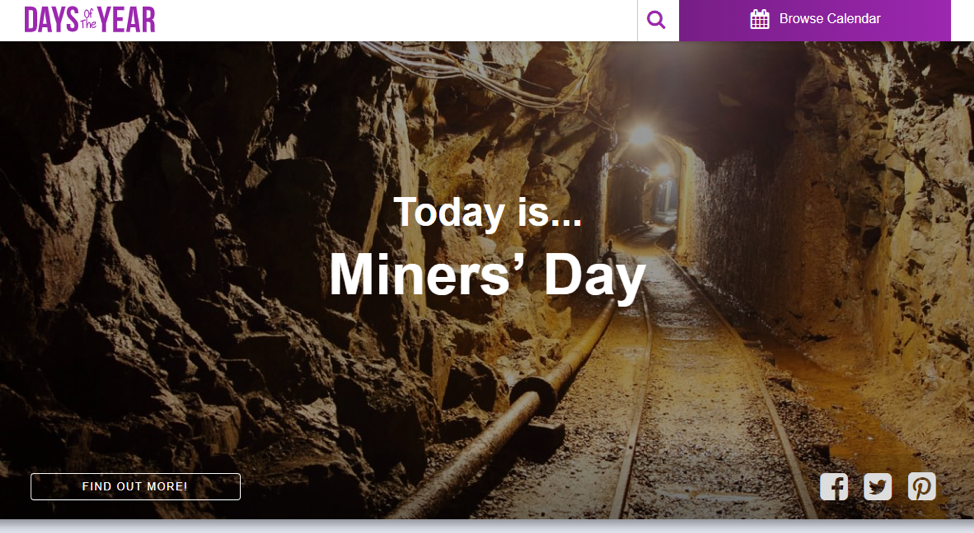
The key to this step is to look carefully for dates which are relevant to your brand. They should make sense to your audience and strengthen your brand when they see them.
Take Captain Morgan, for example.
They take themed days which roughly intersect with drinking rum or making cocktails – like Talk Like A Pirate Day or National Pumpkin Day – to create engaging content for their feeds:
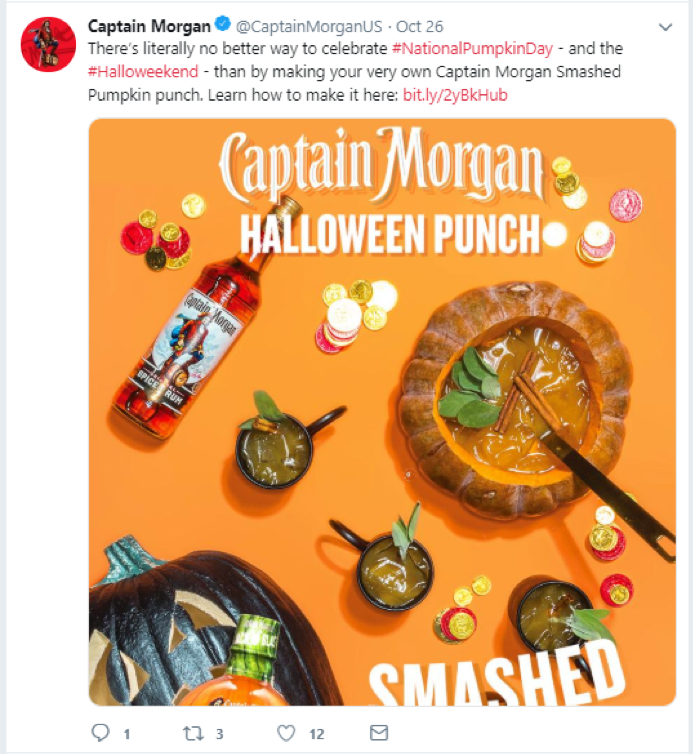
From a customer perspective, this creates some great emotional reaction. Why?
Because they probably:
- Did not know it was National Pumpkin Day.
- Did not know you could make a Pumpkin Punch.
Meaning they are more likely to leave an impression on the person who sees them and prompt them to share the update. Definitely a value-adding update!
Let’s say you were creating updates for a coffee shop to be posted in January. Here are some dates and updates which might work well:
- January 1st — National Hangover Day: “Struggling to get through #NationalHangoverDay? we are offering 30% off espresso to give you the push you need!”
- January 6th — National Bean Day: “Celebrate National Bean Day with the only bean that matters – Coffee.”
- January 24th — National Peanut Butter Day: “When you think the holidays are over and then you remember it is #NationalPeanutButterDay.”
- January 26th — National Spouses Day: “Remember to take 10 minutes for you and your partner this National Spouses Day. Even better, do it with a coffee.”
Okay, there are no award winners in that list. We admit it.
But these are cool little pieces of content which could be shared on your feed and get some engagement.
Before moving onto the next step, go through a few of these calendars to find dates which are relevant to you and your brand, then add them to your list of updates.
Step 5: Plan Your Days Of The Week
Hopefully putting these events and themed days into your social media calendar has taken up a large chunk of what you need to post.
But, you probably still have a small chunk of your calendar left to fill in. So let’s get to work on filling those blanks in, shall we?
To start this process, you are going to look at which days of the week you will be posting on, and what sort of content works well on those days.
Here is an infographic we created to show you the optimal days to be posting on each social media platform so that you can be in the right place at the right time:
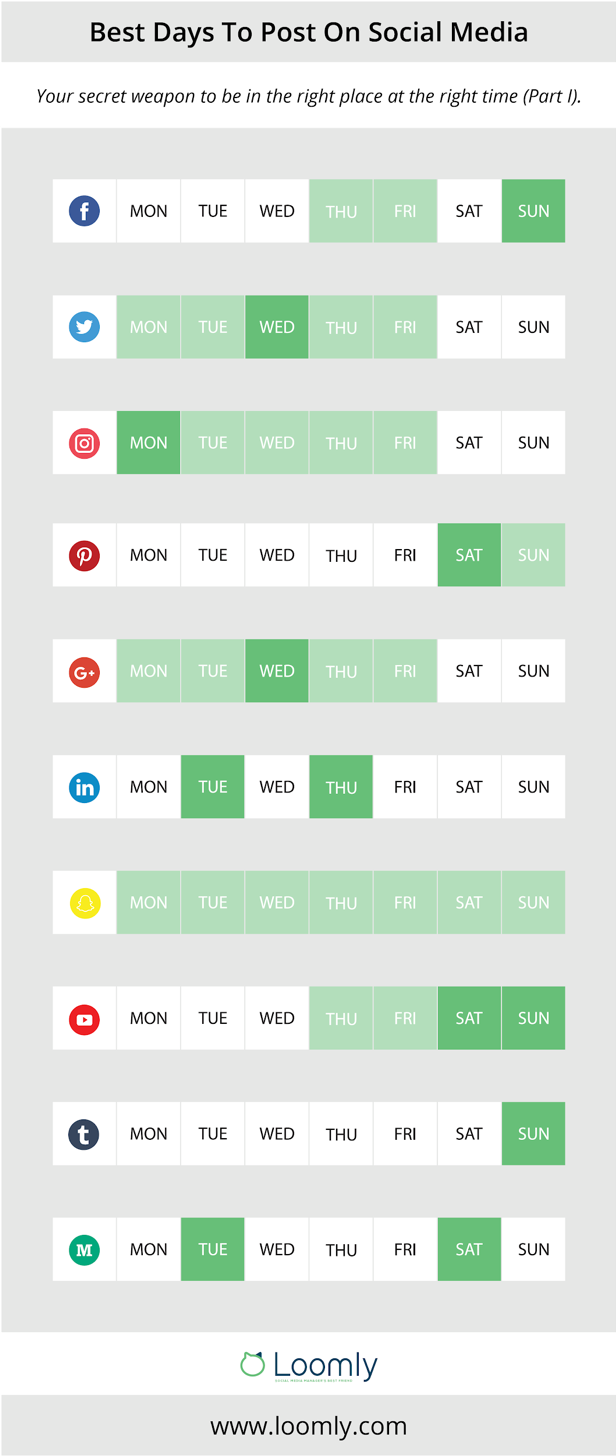
You will probably want to post every day of the week — or at least once every other day — across all of your platforms. So, use the infographic to inform when you should publish your highest value content.
For example, if you are using Facebook and your goal is to drive traffic back to your Shopify store, you may want to save your most impactful post for Sunday.
You can also use the days of the week to structure the content between your cornerstone content.
How?
By using relevant daily hashtags.
You are probably familiar with hashtags like #ThrowbackThursday and #SundayFunday, but these can get much more targeted when you look at your niche more closely.
Taking the time to find out which daily hashtags are used in your industry can help you create timely updates which get lots of exposure.
Let’s say you were creating updates for a fitness brand; you might structure your week around:
- #MotivationMonday
- #TransformationTuesday
- #WorkoutWednesday
- #ThrowbackThursday
- #TGIF
- #SaturdaySweat
- #SundayRunday
Relevant hashtags like this can help you smash through even the most persistent writer’s block, by providing an easy creative framework.
If your hashtag is #WorkoutWednesday, you know you only need to look at posting:
- Workout tips.
- Workout tutorials.
- Workout related third-party content.
- A selfie from the gym.
There are hundreds of variations for each of these, but just having this focus will make it much easier for you to create a great update.
The idea for this step is to create a simple, but easy-to-follow, structure for your week.
You can find a more comprehensive list of hashtags, right here. But we also recommend you do your own research, or use a hashtag auto-suggest tool as we offer with Loomly.
“If what you are doing doesn’t add value, they won’t listen to you.”
— Marcus Sheridan
Step 6: Create Your Remaining Posts With These 11 Evergreen Content Ideas
The final stage of this process is to fill in the remaining slots with any number of these evergreen content ideas.
Through this list you will find 11 ideas which you can replicate in thousands of ways to fill your social media calendar.
Use them as they are. Come at them from new angles. Mix and match them. Whatever works for you.
Here we go…
1. Customer Testimonials
If you receive a testimonial from a customer — like an Amazon review — you can repurpose this into a standalone update.
Big Boys Run Club, for example, turned a Facebook review into a visual post on Instagram:
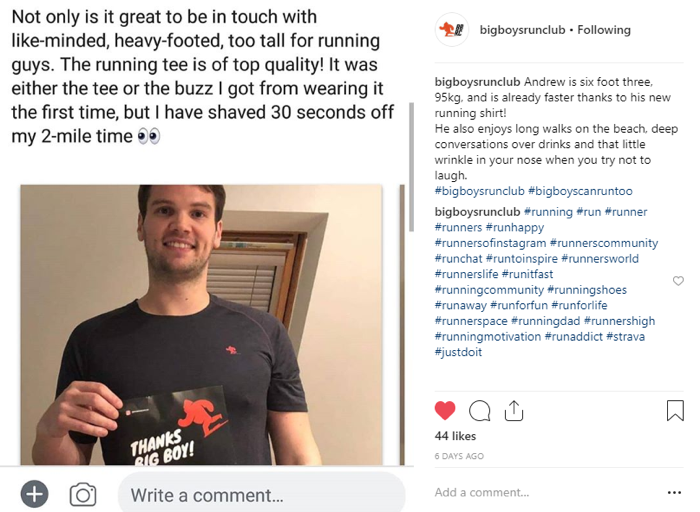
You may need to ask permission if you have received the testimonial privately, like through an email or direct message. But if it is been published openly, feel free to use it!
Simply take a screenshot with your phone and upload it to be reposted.
2. Show A Behind-The-Scenes Insight
Take your followers behind the scenes of how you make your product, what it is like to work in your office, or any major changes that are going on.
The University of Louisville Football has a great example of this on Twitter, where they show an insight into the life of a new coach:
“I picked you guys and I picked this program because I believe in it, and I believe it can be the best in the country.”
????: Go behind the scenes with @CoachSattUofL on his first day in The Ville. pic.twitter.com/VRAWucT6OQ
— LouisvilleFootball (@UofLFootball) December 5, 2018
Your update does not need to be anywhere near as polished. Rather, just enough to give an exciting glimpse.
3. Customer Success Stories
Customer success stories are great for social media. They tell bigger brand stories and can raise brand awareness while converting people to your mailing list (or product sales).
Ramit Sethi does this brilliantly, sharing screenshots of messages from people who have used his free content to improve their lives:
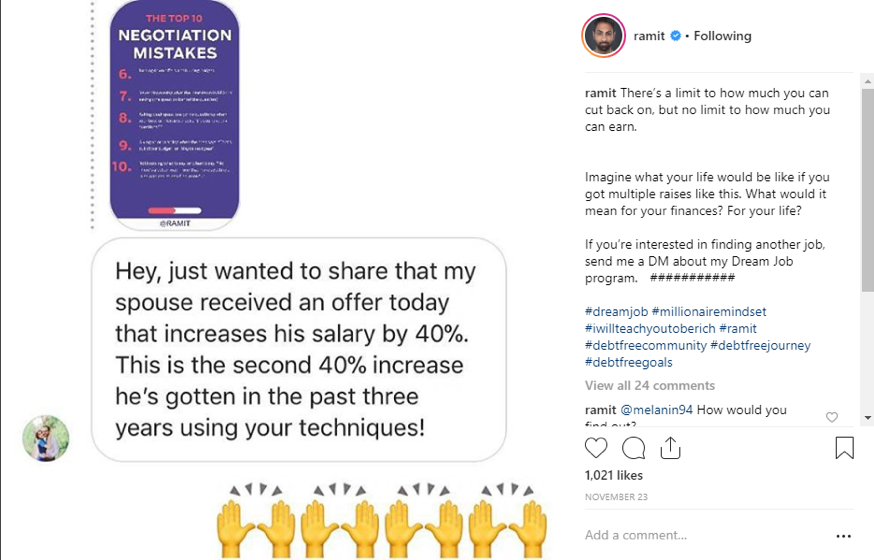
Like testimonials, you may want to ask for permission before sharing this or edit out any personal information they do not want to be included.
4. Share An Industry Statistic (Or New Research)
This type of update is great if you want to show you are on the pulse of your niche. Especially if you work in the business-to-business space.
We regularly use this on our personal and Loomly pages to generate discussions and inform people of what is going on in our world:
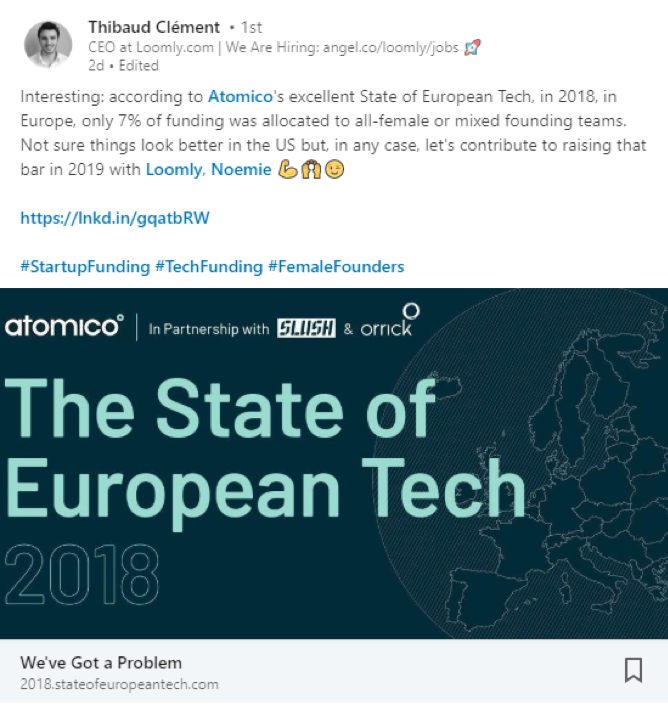
You will often come across this information in your normal day-to-day reading. But, it can also be worth setting up Google Alerts for relevant topics.
5. Share A Third-Party Tutorial On A New Way To Use Your Product
Your customers are out there, every day, using and innovating with your product. Why not showcase some of the ways they use it differently?
AeroPress, a coffee maker manufacturer, do this well across their social feeds.
They have their “standard” way to use their machine, but they embrace people sharing new and inventive ways to use it too:
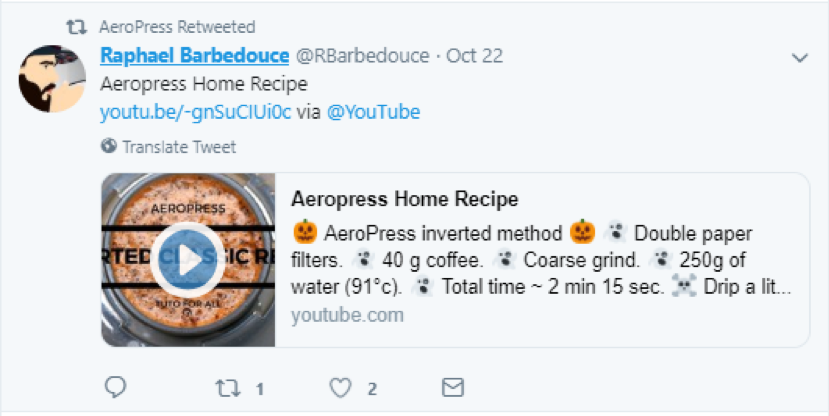
Having the courage to share this shows you are open to advice and feedback from your audience, and can have a truly galvanizing effect.
Note: a direct response of Aeropress being open to new ideas resulted in an AeroPress World Championships. Not a bad example to follow!
6. Share A Podcast Episode You Were Mentioned On (Or Sponsored)
Did someone mention your product or service on a podcast? Or, do you sponsor a specific podcast? Share the episodes with your audience!
Ziprecruiter — who we learned about from them sponsoring Seth Godin’s Akimbo Podcast — do this a lot on their feeds:

The growth of these podcasts is in your interest, so it is worth getting as many people to interact with it as possible!
7. Talk About New Features
Marketers will often tell you to focus on the benefits of your product. But, on social media, you should take the opportunity to talk about some of your product’s features, too!
If there is something new and exciting about your latest update, or a new feature you are adding, share it with your audience:
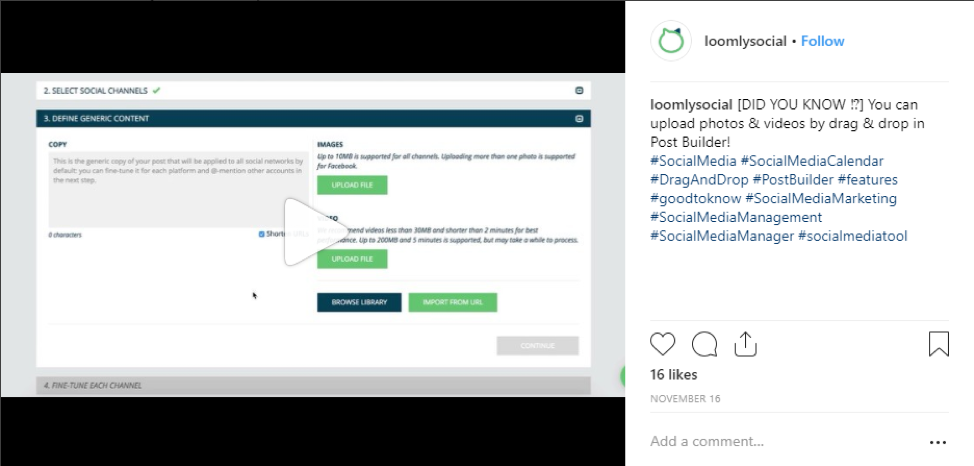
This is something we are trying to do more of at Loomly, and we have found it is a great way to educate potential customers and gather feedback for future changes.
8. Talk About Old Versions Of Your Product
Part of brand storytelling is talking about the journey to where you are now. The progressions, the changes, the mistakes and the funny anecdotes.
If you have come a long way from your first iteration (we know we have!) try sharing part of that story on your feeds.
AeroPress have another great example of this. Although they are a world-leading coffee brand now, they started life as a frisbee company:

These little updates help to build the bigger picture of your brand. They can engage the people who were there at the start, and enlighten the people who are just finding out about you.
9. Share An Employee Story
Employees are a big part of your brand. They use their boots-on-the-ground perspective to keep it alive, and make your customers happy.
So, why not give them a feature on your social feeds? A few customers might even know them!
Marriott Careers do this brilliantly on Twitter, praising their staff and giving them the recognition they deserve:
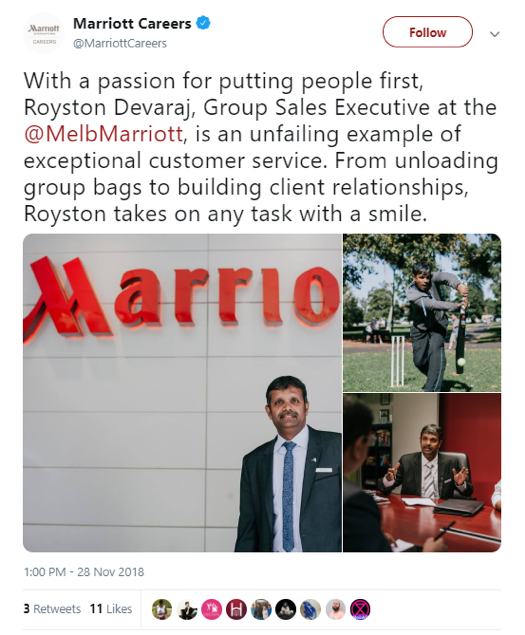
As employer branding becomes more important in 2019 and beyond, you can use these updates to make your company and products seem more attractive to both customers and potential candidates.
10. Talk About A Charity Event
Charity events help to document the attitude of your brand and the causes you care about. They also help customers to see you as more than just a company selling a product.
L’Oreal have done this really well over on their Instagram feed, where they featured employees and staff events which raised 20,426 EUR for Movember:

You do not need to ask for donations, either. You can simply document what you as a company, or one of your employees, is doing for the cause.
11. Create A Branded Video Message
Think of this as like a short “commercial” for a product, event, offer and occasion which is coming up.
It can be funny, informative, weird, emotional, whatever fits your brand. But it should have a clear point on be on your brand message.
Chubbies, a men’s clothing brand, do this really well. Their videos are funny, tongue-in-cheek but are still professional enough to promote a product well.
Take a look at this example from their Cyber Monday campaign, which they called “Thigh-ber Monday”:
Again, your video does not need to be this polished. It can be you, your phone camera, and a great idea. But this kind of content has potential to get great engagement!
Wrapping This Up…
How did you get on creating your updates for the next cycle?
We hope with the help of this article you have been able to create a high-quality set of updates, with much less effort and without any writer’s block.
They key to this strategy is to:
- Add your most important updates first: these are your brand events, and relevant dates, which your audience needs to know about.
- Add your long-form content: share your most valuable pieces – like blog posts and podcasts – to ensure people can see it and interact with it.
- Repurpose that content: and create mini-updates using snippets or quick breakdowns of what you have shared in your long-form pieces.
- Look for relevant days: and find unique ways to connect with what is going on in your audience’s world.
- Fill in the gaps: by structuring your week and using evergreen content ideas.
Cherry on the cake: you can wash, rinse and repeat this strategy as much as you need to.
